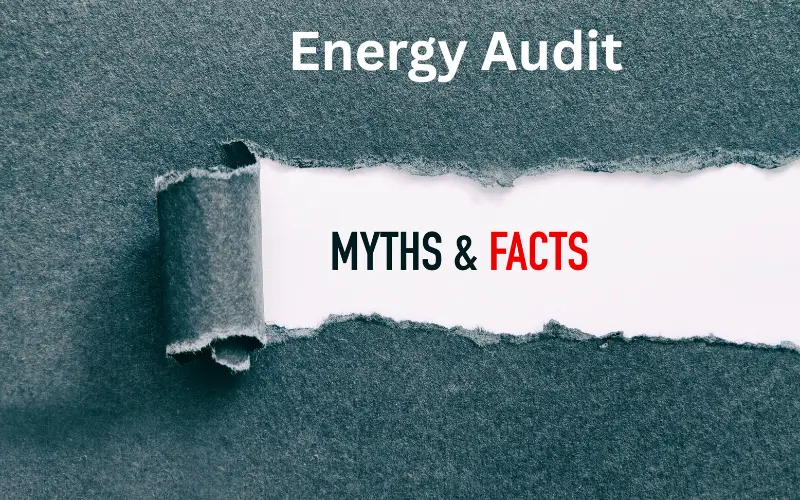Have you ever looked at your energy bills and wondered, “Why are these costs rising even though nothing’s changed?” The answer might lie in unseen energy inefficiencies silently building up over time. That’s where annual energy audits come in.
An energy audit is a thorough inspection and analysis of how energy flows through your building — whether it’s your home, office, or factory. While a one-time audit is helpful, scheduling energy audits every year ensures that you stay ahead of rising energy costs, prevent long-term inefficiencies, and continually improve your energy usage.
In this guide, we’ll explore:
- What an energy audit actually involves,
- Why you should make it a yearly priority, and
- How it can help lower bills, improve comfort, and boost the value of your property.
Let’s dive into why your calendar should include an annual energy audit schedule — not as an option, but as a smart and proactive strategy.
What Is an Energy Audit?
An energy audit is a systematic examination of how energy is used, where it’s wasted, and how it can be conserved in a building. Whether it’s a home, office, or industrial site, the goal is the same: identify inefficiencies and suggest practical improvements to reduce energy consumption and cost.
a. Definition & Purpose
At its core, an energy audit tracks how energy moves through your space. It pinpoints:
- Inefficient appliances or systems,
- Air leaks and insulation issues,
- Lighting, ventilation, and HVAC inefficiencies, and
- Behavioral patterns affecting usage.
Audits don’t just highlight problems — they also provide a clear, prioritized roadmap of solutions tailored to your building and budget. Think of it as a health check-up, but for your energy use.
b. Types of Energy Audits
Depending on the depth of analysis and the type of property, audits are generally categorized into three main types:
Level I: Walk-Through Audit
- A basic, low-cost visual inspection.
- Identifies obvious issues like poor lighting, outdated systems, or missing insulation.
- Ideal for quick assessments or smaller buildings.
Level II: General Energy Audit
- Includes data analysis, utility bill evaluation, and on-site measurements.
- Provides cost-benefit analysis for recommended changes.
- Commonly used in commercial and industrial settings.
Level III: Investment-Grade Audit
- In-depth engineering study with detailed simulations and ROI analysis.
- Recommended for major upgrades, renovations, or large-scale energy strategies.
- These levels ensure flexibility — from a simple home energy check to a full-scale commercial performance evaluation.
c. Residential vs. Commercial Audits
While the process is similar, the focus areas vary:
- Residential audits usually target insulation, windows, appliances, and HVAC.
- Commercial audits may also cover production equipment, building automation systems, and operational schedules.
In both cases, audits help align energy use with the unique demands of the space — while ensuring compliance with local codes, certifications (like LEED), or sustainability targets.
Why Do It Annually?
Many building owners treat energy audits as a one-time event — but that’s a critical mistake. Just like equipment requires routine maintenance, your building’s energy performance also evolves over time. An annual energy audit schedule ensures that you’re not only solving today’s issues but also staying ahead of tomorrow’s inefficiencies.
a. Track Changes & Measure Improvements
Energy-saving upgrades can degrade, and building usage often changes year-to-year. By conducting yearly audits, you can:
- Benchmark progress: Compare each year’s performance and confirm if energy-saving measures are working.
- Identify recurring inefficiencies: For example, if insulation effectiveness declines over time, you’ll catch it before bills spike.
- Maintain continuous improvement: Annual audits foster a cycle of review, refine, and improve — a key principle in energy management.
“You can’t manage what you don’t measure.” Annual audits give you the data to do both.
b. Catch Emerging Issues Early
Energy issues can creep up silently — drafty windows, aging HVAC motors, or inefficient lighting aren’t always obvious. An annual audit helps detect:
- Air leaks and duct losses before they become costly.
- Equipment nearing failure (e.g., motors drawing too much power).
- Mold or ventilation issues that affect indoor air quality and health.
- Early detection leads to cheaper fixes and avoids disruptive breakdowns later.
c. Ensure Peak System Efficiency
Energy systems — especially HVAC, lighting, and automation — lose efficiency over time due to wear, incorrect settings, or lack of maintenance. Annual audits help:
- Recalibrate systems and thermostats,
- Optimize usage based on new occupancy or seasonal patterns,
- Prevent gradual inefficiency from turning into significant waste.
In essence, yearly audits are your safeguard to keep everything running at peak performance without burning more energy than necessary.
Core Benefits of Yearly Audits
Scheduling an annual energy audit isn’t just a checkbox — it’s a strategic move with wide-ranging benefits that affect your bottom line, comfort, and even environmental impact. Here’s what you gain when you make it a yearly habit:
a. Lower Energy Bills
This is the most immediate and visible benefit. By identifying energy leaks, inefficient appliances, and wasteful behaviors, yearly audits can lead to:
- Energy savings of 10–40%, depending on building type and condition.
- Reduced usage of electricity, gas, or other fuels.
- Lower demand charges (especially for commercial or industrial setups).
Real-world impact: A home audit can cut bills by $200–$400 per year. For businesses, the savings can climb into the tens of thousands.
b. Enhanced Comfort & Indoor Air Quality
Drafts, poor insulation, and outdated HVAC systems don’t just waste energy — they also reduce comfort. Annual audits help improve:
- Temperature consistency across rooms,
- Humidity control, reducing mold risks,
- Ventilation effectiveness, improving air quality and health.
This is especially important for homes with children, elderly residents, or workplaces that rely on employee well-being.
c. Improved Resale Value
Energy-efficient buildings are more attractive to buyers. When you show documented energy savings from annual audits, you:
- Boost property value (energy-efficient homes can sell for 2–6% more),
- Create a competitive advantage with certifications (like ENERGY STAR),
- Appeal to buyers concerned about rising utility costs.
d. Environmental Responsibility
Reducing your energy use also means lowering your carbon footprint. Annual audits help you:
- Use less electricity and natural gas,
- Emit fewer greenhouse gases,
- Align with sustainability goals or ESG compliance (especially important for businesses).
A small yearly change in energy use adds up to major environmental impact over a decade.
e. Smarter Budgeting & Maintenance Planning
Annual audits help you forecast repairs and replacements before they become emergencies:
- Predict HVAC end-of-life before a summer breakdown,
- Plan capital investments gradually instead of reacting to failures,
- Avoid unexpected downtime in operations.
Think of audits as a financial planning tool — helping you allocate funds wisely, year after year.
What an Annual Audit Involves
Now that you know why annual audits matter, let’s break down what actually happens during the process. Whether you’re doing it for your home or your business, an annual energy audit typically follows a structured approach to maximize accuracy and effectiveness.
a. Professional vs. DIY Audits
You can choose between:
- DIY Audits: Great for identifying basic issues like air leaks, poor insulation, or outdated bulbs.
- Professional Audits: Conducted by certified experts using specialized tools. Ideal for in-depth analysis, especially for larger buildings or complex systems.
Professional audits often include:
- Blower door tests (to detect air leakage),
- Thermographic imaging (to find heat loss),
- Duct testing,
- Real-time power monitoring.
b. Key Components of an Energy Audit
A full audit usually covers:
Utility Bill Analysis
- Review of 12–24 months of past bills.
- Identifies trends, anomalies, or seasonal spikes.
Building Envelope Inspection
- Insulation, windows, doors, roofing.
- Tests for air leaks, drafts, and moisture intrusion.
HVAC System Evaluation
- Checks heating, cooling, and ventilation performance.
- Measures efficiency (e.g., SEER, AFUE ratings).
Lighting & Appliances
- Audit of lighting layout, bulb types, controls (timers/sensors).
- Appliance efficiency and operating schedules.
Plug Loads & Miscellaneous Equipment
- Standby loads (phantom energy) from electronics.
- Equipment scheduling in commercial buildings.
c. Frequency & Ideal Timing
Even if nothing “feels” wrong, performing an audit every 12 months helps catch gradual shifts. Ideal times to schedule an audit:
- Before the start of winter or summer, when HVAC use spikes.
- After any major equipment installation or renovation.
- At the end of your fiscal year (for businesses), to align with budgeting and reporting cycles.
d. Who Should Conduct It?
Look for certified professionals or firms with experience in your building type. Consider:
- BPI (Building Performance Institute) or RESNET certified assessors (for homes),
- ESCOs (Energy Service Companies) for large commercial/industrial properties,
- Local utility companies — some offer free or discounted audits.
Use trusted directories like ENERGY STAR’s audit program or local energy efficiency networks to find qualified providers.
Cost & Incentives
One of the most common questions people ask before scheduling an audit is, “How much will it cost?” The good news? Annual energy audits are relatively affordable — and in many cases, the savings they unlock quickly outweigh the cost.
a. Typical Costs of an Energy Audit
Costs vary depending on the type, size, and complexity of your property:
Residential Audits
- Basic walk-through audits: Often free or low-cost through utility companies.
Comprehensive audits (including blower door tests, infrared scans):
- Cost: $200–$500
- Duration: 2–4 hours
Commercial/Industrial Audits
Priced per square foot:
- Average: $0.05–$0.50 per sq ft
- Level II or III audits with full ROI analysis may cost $2,000–$15,000, depending on the scope.
- However, many businesses treat audits as capital investment, often recovering the cost within a year.
b. Rebates, Tax Credits & Other Incentives
There are multiple financial incentives available to offset the cost of audits and recommended improvements.
Utility Company Programs
Many local power providers offer:
- Free or subsidized audits (especially for residential customers),
- Instant rebates on energy-saving products (LEDs, smart thermostats, etc.),
- Follow-up support for implementing changes.
Check your provider’s website for offers under terms like “Home Energy Assessment” or “Business Efficiency Program.”
Federal Tax Credits (U.S.)
Under the Inflation Reduction Act (2022):
- You can claim a 30% federal tax credit on the cost of a qualified home energy audit (up to $150).
- Applies to services performed by certified professionals.
- Visit EnergyStar.gov for eligibility details.
State & Local Incentives
Some states and municipalities provide:
- Property tax exemptions for energy-efficient upgrades,
- Grants for deep energy retrofits,
- Low-interest financing options (e.g., PACE programs).
Search the Database of State Incentives for Renewables & Efficiency (DSIREUSA.org) to explore what’s available in your area.
How to Prepare for Your Audit
A successful energy audit starts with good preparation. While certified professionals handle the technical aspects, you can take a few simple steps to maximize the value of the visit and ensure no detail is overlooked.
a. Pre-Audit Checklist
Before the auditor arrives, gather this information and take the following steps:
Collect Utility Bills
- Provide at least 12 months of utility history (electricity, gas, water).
- These help identify usage patterns and anomalies.
Make a List of Concerns
Draft a quick note of known issues, like:
- Drafts in specific rooms,
- HVAC underperformance,
- High summer or winter bills,
- Humidity or ventilation problems.
Provide Full Access
Clear access to:
- Attics, basements, and crawlspaces,
- Utility meters, electrical panels, HVAC systems,
- Windows, doors, vents, and ducts.
Secure Pets & Inform Occupants
- Make sure pets are safe and auditors can move freely.
- Inform tenants/employees if the audit is for a shared or commercial space.
b. What the Auditor Will Do
Here’s what to expect during a standard professional energy audit:
Visual Inspection
- Reviews the building’s exterior and interior,
- Checks insulation, seals, windows, lighting, and appliances.
Utility Data Analysis
- Compares usage trends,
- Calculates base load vs. seasonal peaks,
- Determines energy intensity (kWh per square foot, for example).
Blower Door Test
- Measures how airtight the building is.
- Identifies leaks around doors, windows, and wall penetrations.
Infrared Thermography
- Detects heat loss and insulation gaps using a thermal imaging camera.
Duct & Ventilation Testing
- Checks for leakage in ductwork,
- Evaluates airflow and air exchange rates for health and comfort.
Lighting & Equipment Audit
- Assesses efficiency of lights, appliances, office machines, etc.
- Recommends replacements or automation options.
The entire process typically takes 2–4 hours for a home and 1–2 days for a larger commercial property.
After the Audit
The audit is only the first step toward energy efficiency. What truly makes a difference is what you do with the results. A professional energy audit provides a detailed report — now it’s time to act on it strategically.
a. Understanding the Audit Report
Your auditor will typically provide a comprehensive report outlining:
- Summary of findings: Key problem areas and inefficiencies.
- Breakdown by system: HVAC, lighting, insulation, envelope, etc.
- Energy usage analysis: Charts showing trends and high-consumption zones.
- Prioritized recommendations: Ranked by ROI, urgency, and impact.
b. Implementing Changes
Once you have your report in hand, the next step is to put the insights into action. Most reports will categorize recommendations into:
Low/No-Cost Fixes
- Sealing gaps around windows and doors,
- Adjusting thermostat settings,
- Installing smart power strips.
Medium Investments
- Upgrading to ENERGY STAR-rated appliances,
- Adding attic or wall insulation,
- Replacing incandescent bulbs with LEDs.
Capital-Intensive Improvements
- HVAC system upgrades or replacements,
- Window replacements,
- Building automation system integration (for commercial spaces).
c. Measuring Impact Over Time
To get the most from your audit, track your energy usage in the months that follow:
- Compare utility bills before and after improvements.
- Use tools like ENERGY STAR Portfolio Manager or smart meters.
- Document new issues or maintenance needs for your next annual audit.
Annual Audit Case Studies
Seeing real-life examples of annual energy audits can help you understand their practical benefits. Below are case studies from both residential and commercial settings illustrating the value of a regular audit schedule.
a. Residential Example
The Johnson Family Home
- Before audit: The Johnsons noticed rising energy bills and uneven heating in their 20-year-old home.
- Audit findings: The professional audit revealed air leaks around windows and an inefficient furnace.
- Actions taken: Sealed gaps with weatherstripping, upgraded to a high-efficiency furnace, and added attic insulation.
- Results: Within a year, the family reduced energy bills by 25%, improved indoor comfort, and qualified for a local rebate program.
- Follow-up: Scheduled audits every year helped catch a leaking duct in year two, avoiding costly repairs.
b. Commercial/Industrial Example
ABC Manufacturing Plant
- Before audit: The plant was experiencing high energy consumption during peak production months.
- Audit findings: Inefficient lighting and outdated HVAC controls were identified.
- Actions taken: Installed LED lighting, upgraded HVAC automation, and trained staff on energy-saving protocols.
- Results: Achieved a 30% reduction in energy costs and increased equipment lifespan.
- Follow-up: Annual audits provided ongoing recommendations, enabling proactive maintenance and sustained savings.
c. Energy Savings & ROI
Both cases highlight key lessons:
- Annual audits enable continuous improvement, not just one-time fixes.
- Savings often pay for the audit and upgrades within 1–2 years.
- Regular scheduling helps avoid surprises and extend equipment life.
Common FAQs
When should I schedule an annual energy audit?
Ideally, schedule it once every 12 months, preferably before peak heating or cooling seasons to prepare your systems for heavy use.
Do I need a professional auditor every year?
While minor DIY checks can help, a full professional audit annually ensures comprehensive detection of issues and accurate recommendations.
How long does an energy audit usually take?
A residential audit generally takes 2–4 hours; commercial audits can range from a day to several days depending on size and complexity.
Can I skip audits if I’ve done major improvements?
Even after upgrades, systems degrade over time. Annual audits catch new inefficiencies early and verify that improvements are performing as expected.
Are energy audits worth the cost?
Yes! Most audits pay for themselves through energy savings, increased comfort, and extended equipment lifespan.
Conclusion
Scheduling an annual energy audit is one of the smartest steps you can take to manage your energy costs, improve comfort, and reduce your environmental footprint. By regularly assessing your building’s energy use, you stay ahead of hidden inefficiencies, extend equipment life, and make informed decisions that save money in the long run.
Whether you’re a homeowner or business manager, making an annual energy audit schedule a priority ensures continuous improvement and energy efficiency that keeps pace with changing needs. Don’t wait for high bills or system failures — start the cycle of savings and comfort today by planning your next audit.




